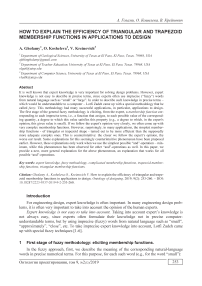How to explain the efficiency of triangular and trapezoid membership functions in applications to design
Автор: Gholamy A., Kosheleva O., Kreinovich V.
Журнал: Онтология проектирования @ontology-of-designing
Рубрика: Методы и технологии принятия решений
Статья в выпуске: 2 (32) т.9, 2019 года.
Бесплатный доступ
It is well known that expert knowledge is very important for solving design problems. However, expert knowledge is not easy to describe in precise terms, since experts often use imprecise (“fuzzy”) words from natural language such as “small” or “large”. In order to describe such knowledge in precise terms - which would be understandable to a computer - Lotfi Zadeh came up with a special methodology that he called fuzzy. This methodology had many successful applications, in particular, applications to design. The first stage of the general fuzzy methodology is eliciting, from the expert, a membership function corresponding to each imprecise term, i.e., a function that assigns, to each possible value of the corresponding quantity, a degree to which this value satisfies this property (e.g., a degree to which, in the expert's opinion, this given value is small). If we follow the expert's opinion very closely, we often come up with very complex membership functions. However, surprisingly, in many applications, the simplest membership functions - of triangular or trapezoid shape - turned out to be more efficient than the supposedly more adequate complex ones. This is counterintuitive: the closer we follow the expert’s opinion, the worse our result. Some explanations for this seemingly counterintuitive phenomenon have been proposed earlier. However, these explanations only work when we use the simplest possible “and”-operation - minimum, while this phenomenon has been observed for other “and”-operations as well. In this paper, we provide a new, more general explanation for the above phenomenon, an explanation that works for all possible “and”-operations.
Expert knowledge, fuzzy methodology, complicated membership functions, trapezoid membership functions, triangular membership functions
Короткий адрес: https://sciup.org/170178569
IDR: 170178569 | DOI: 10.18287/2223-9537-2019-9-2-253-260
Список литературы How to explain the efficiency of triangular and trapezoid membership functions in applications to design
- Zadeh LA. Fuzzy sets. Information and Control. - 1965; 8: 338-353.
- Klir GJ, Yuan Bo. Fuzzy Sets and Fuzzy Logic, Theory and Applications. Prentice Hall, Upper Saddle River, New Jersey. 1995. - 592 p.
- Novak V, Perfilieva I, Mockor J. Mathematical Principles of Fuzzy Logic. Kluwer, Boston, Dordrecht. 1999. (Математические принципы нечёткой логики / Новак В., Перфильева И., Мочкор Ж. //Пер с англ.; Под ред. Аверкина А.Н. - М.: ФИЗМАТЛИТ, 2006. - 352 с.)
- Nguyen HT, Walker EA. A First Course in Fuzzy Logic. Chapman and Hall/CRC, Boca Raton, Florida. 2006. - 430 p.
- Belohlavek R, Dauben JW, Klir GJ. Fuzzy Logic and Mathematics: A Historical Perspective. Oxford University Press, New York. 2017. - 522 p. - https://b-ok.org/book/2925381/efa85d.
- Mendel JM. Uncertain Rule-Based Fuzzy Systems: Introduction and New Directions. Springer, Cham, Switzerland. 2017. - DOI: 10.1007/978-3-319-51370-6
- Kosheleva O, Kreinovich V, Shahbazova S. Type-2 Fuzzy Analysis Explains Ubiquity of Triangular and Trapezoid Membership Functions, Proceedings of the World Conference on Soft Computing, Baku, Azerbaijan, May 29-31. 2018.


